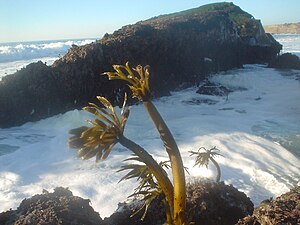Sea palm
| Sea palm | ||||||||||||
|---|---|---|---|---|---|---|---|---|---|---|---|---|

Sea palm ( Postelsia palmaeformis ) |
||||||||||||
| Systematics | ||||||||||||
|
||||||||||||
| Scientific name of the genus | ||||||||||||
| Postelsia | ||||||||||||
| Rupr. | ||||||||||||
| Scientific name of the species | ||||||||||||
| Postelsia palmaeformis | ||||||||||||
| Rupr. |
The sea palm , Postelsia palmaeformis, is a brown alga from the Laminariales group and the only species of the genus Postelsia . It is common on the surf-rich coasts of the Northeast Pacific .
description
The sea palm is an olive-green to olive-brown seaweed that reaches a height of 20 to 40, rarely up to 60 centimeters. The annual thallus grows upright and resembles a palm tree with a trunk and tuft of leaves. It is anchored to the rocky subsoil with an adhesive organ ( rhizoid ) made of relatively short, branched haptera. The stalk ( cauloid ) is thick, tubular, resilient and elastic and becomes thinner towards the top. Numerous stalked leaf organs ( phylloids ) of 10 to 25 centimeters in length arise at its tip . These are narrow strip-shaped and taper to a point. The leaf surface has deep parallel furrows on both sides, the leaf edges are serrated.
Development cycle
As with all laminariales , the visible tang is the sporophyte . The sea palm is annual and survives until winter, when it is usually torn off by the violent waves. The spores are already formed in the deep furrows of the phylloids in late spring to early summer . After their release, the individual leaf organ degenerates. The immobile spores usually land near the base of the sporophyte, attach themselves to the subsurface and develop into microscopic male and female gametophytes , which consist only of cell threads. The gametophytes survive until late winter or early spring, then they form egg cells or sperm . After fertilization, a new sporophyte grows from the zygote .
The spores can usually only overcome a distance of one to three meters. The spread over further distances probably takes place via torn sporophytes that have not yet released their spores.
Occurrence
The sea palm is widespread in the northeast Pacific on the coasts from British Columbia to California . It colonizes rocky subsoil within the intertidal zone in locations exposed to strong waves. There it often forms dense stands.
ecology
The sea palm is dependent on locations with strong surf . Not only does it receive sufficient nutrients and direct sunlight there. Mussels are repeatedly torn from the underground so that their spores can germinate there. Their main competitor for the habitat is the Mytilus californianus mussel . Young sporophytes, focusing on mussels, barnacles and other algae have settled, tear down this off by the force of the waves from the rock, characterized Place is also the postelsia created for new sporophyte.
The alga is also eaten by beetle snails and limpets , but their rapid growth means that they are less affected.
Systematics
The species was first described in 1852 by Franz Josef Ruprecht (In: New or incompletely known plants from the northern part of the Pacific Ocean. Mémoires de l'Académie Impériale des Sciences de Saint-Pétersbourg, Sixième Série, Sciences Naturelles 7: p. 55– 82). It was first found near Bodega Bay in California . A later synonym is Virginia palma-maris Areschoug.
Postelsia palmaeformis is the only species in the genus Postelsia . The generic name honors the Baltic German natural scientist Alexander Postels . The genus is assigned to the family Laminariaceae .
use
Postelsia palmaeformis is edible. To conserve stocks, California bans harvesting for occasional use. However, licenses are issued for commercial use with costs. The harvest in 2000 and 2001 is estimated at two to three tons.
The leaf organs of the sea palm can be eaten raw. Usually they are sold dried in Asian markets or health food stores and used for soups and salads.
swell
- ↑ a b c Michael D. Guiry, GM Guiry: Postelsia palmaeformis - In: Algaebase - World-wide electronic publication, National University of Ireland, Galway, accessed October 29, 2014
- ↑ a b c Wolfram Braune: Marine algae. A color guide to the common benthic green, brown and red algae of the world's oceans . Ruggell: Gantner, 2008, ISBN 978-3-906166-69-8 , pp. 208-209.
- ↑ a b c d e Sarah Oehm: " Postelsia ." ( Memento of the original dated February 8, 2007 in the Internet Archive ) Info: The archive link was inserted automatically and has not yet been checked. Please check the original and archive link according to the instructions and then remove this notice. , Monterey Bay Aquarium Research Institute. 1999, accessed October 29, 2014.
- ↑ a b Kathy Ann Miller: 3. Sea Palm , Annual Status of the Fisheries Report, California Fish and Wildlife Department, revised 2002, (pdf) accessed October 29, 2014.

